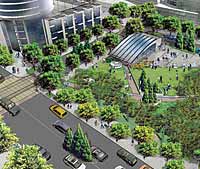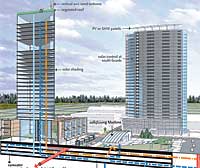The Zero Effect
Learning Objectives:
- Define what contributes to carbon emissions.
- Explain the differences between the types of net zero concepts.
- Discuss the status of the zero-energy home market.
Credits:
Today you've exhaled, on average, 2.2 pounds of carbon dioxide (CO2), the greenhouse gas poster child for our current fascination with global warming. Just by breathing, you've entered a cycle of carbon emission and sequestration, an environmental chess game with consequences that are well documented, if little understood. Americans will emit roughly 44,000 pounds of CO2 per capita this year, an amount over three times the per capita average for the world. And if you're thinking of planting a forest to offset your last trip to Las Vegas, keep in mind the U.S. Department of Agriculture estimates a healthy tree can consume roughly 13 pounds of CO2 in a year.
Truth be told, human breathing contributes nothing to global warming. We each eat plenty of plants, which act as carbon sinks since they absorb carbon dioxide from the atmosphere, and thus by eating we remove a great deal of carbon dioxide from the environment on a daily basis. If anything, we can breath easier knowing respiration qualifies as a carbon-neutral activity. Such calculated explanations underscore the complications of accounting for carbon emissions across the broad spectrum of our lives-the food we eat, the places we go, the energy we consume, and increasingly, the buildings and cities we create.
Bert Gregory, FAIA, thinks about these kinds of things a lot. As president and C.E.O. of Seattle-based Mithun, an architecture and planning office with a sustainable design specialty, Gregory has literally gone back to nature. In his work on Mithun's Lloyd Crossing Sustainable Urban Design Plan and Catalyst Project, a 2004 master plan for a downtrodden section of downtown Portland, Oregon, Gregory and his team began its work by conceptually recreating the native ecosystem of the site's 54 acres to determine exactly how much CO2 would be absorbed and emitted annually if no human development had ever occurred. The redevelopment plan would then have to match, if not beat, this carbon footprint. "We couldn't analyze everything because the project resources weren't there, so we focused on high-level things," Gregory says, referring to the plan's key issues of energy and water.
When setting up its predevelopment metrics, Mithun's team found that the yearly baseline of the native Northwest conifer forest landscape would have produced 32 million gallons of groundwater recharge out of 64 million gallons of total precipitation. Calculating that 8 million kilowatt hours (kwh) of solar energy contributed to photosynthesis per year, the team determined that 153 million kwh remained as reflected, absorbed, or re-radiated energy. For the site's carbon balance, the team found that annually the forest consumed 681 tons of CO2, released 495 tons of oxygen, and fixed 186 tons of carbon as biomass (such as new tree growth). The team now faced the question of how over the four decades of the plan's premise you develop an existing infrastructure into an economically viable district that would be a forest in function, if not appearance.











